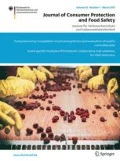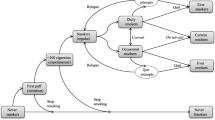Abstract:
In consequence of the health hazards of smoking and environmental tobacco smoke (ETS) and the high prevalence in the German population there are more than 100,000 deaths annually in Germany. Still more than half of the German population ever starts smoking and currently about a third of the adult population and a fifth of the adolescents are smokers at present. Additionally about 55 percent of all non-smokers between the age of 18 and 79 are often exposed to ETS at home, at work or in their leisure time. A differentiation of smoking prevalence and of exposure to ETS concerning socio-economic determinants shows that social differences have grown with successive birth cohorts. Thus, significant social inequalities can be observed today. In contrast to this, gender differences are becoming increasingly irrelevant, particularly in smoking prevalence. Tobacco consumption and ETS therefore has become one high-priority field of action of health and prevention politics in Germany, which manifests in an improved tobacco control policy. International achievements in the implementation of a comprehensive tobacco control policy show however, that in Germany further efforts are needed to reduce smoking prevalence significantly.
Zusammenfassung:
In Folge der hohen individuellen Gesundheitsgefahren des Rauchens und Passivrauchens sowie der starken Verbreitung in der Bevölkerung versterben in Deutschland über 100,000 Menschen pro Jahr. Trotzdem beginnt mehr als die Hälfte der deutschen Bevölkerung jemals im Leben mit dem Rauchen und aktuell raucht etwa ein Drittel der Erwachsenenbevölkerung und mindestens ein Fünftel der Jugendlichen. Zusätzlich sind in Deutschland 55% aller Nichtraucher zwischen dem 18. und 79. Lebensjahr häufig zu Hause, am Arbeitsplatz oder in der außerhäuslichen Freizeit mit Tabakrauch belastet. Eine Differenzierung der Raucheranteile und Passivraucheranteile nach sozioökonomischen Merkmalen zeigt, dass diesbezügliche Unterschiede in der Kohortenfolge stark gewachsen sind und heute ausgeprägte soziale Ungleichheiten beobachtet werden können. Die Geschlechtsunterschiede, insbesondere beim aktiven Tabakkonsum, verlieren demgegenüber jedoch zunehmend an Bedeutung. Aufgrund der Verbreitung und der gesundheitlichen Folgen gehören Tabakkonsum und Passivrauchen mittlerweile zu den prioritären Aktionsfeldern der Gesundheits- und Präventionspolitik in Deutschland. Dies äußert sich auch in einer verbesserten Tabakkontrollpolitik in den letzten Jahren. Allerdings zeigen die international erzielten Erfolge bei der Umsetzung einer umfassenden Tabakkontrollpolitik, dass in Deutschland weitere Anstrengungen erforderlich sind, um die Rauchprävalenz spürbar zu verringern.
Similar content being viewed by others
Author information
Authors and Affiliations
Corresponding author
Additional information
Übersichtsarbeit
Eingegangen: 11. Mai 2007; Angenommen: 15. Mai 2007
Rights and permissions
About this article
Cite this article
Schulze, A., Mons, U. & Lampert, T. Ausmaß und Folgen des Tabakkonsums und Passivrauchens in Deutschland. J. Verbr. Lebensm. 2, 323–330 (2007). https://doi.org/10.1007/s00003-007-0192-9
Published:
Issue Date:
DOI: https://doi.org/10.1007/s00003-007-0192-9




